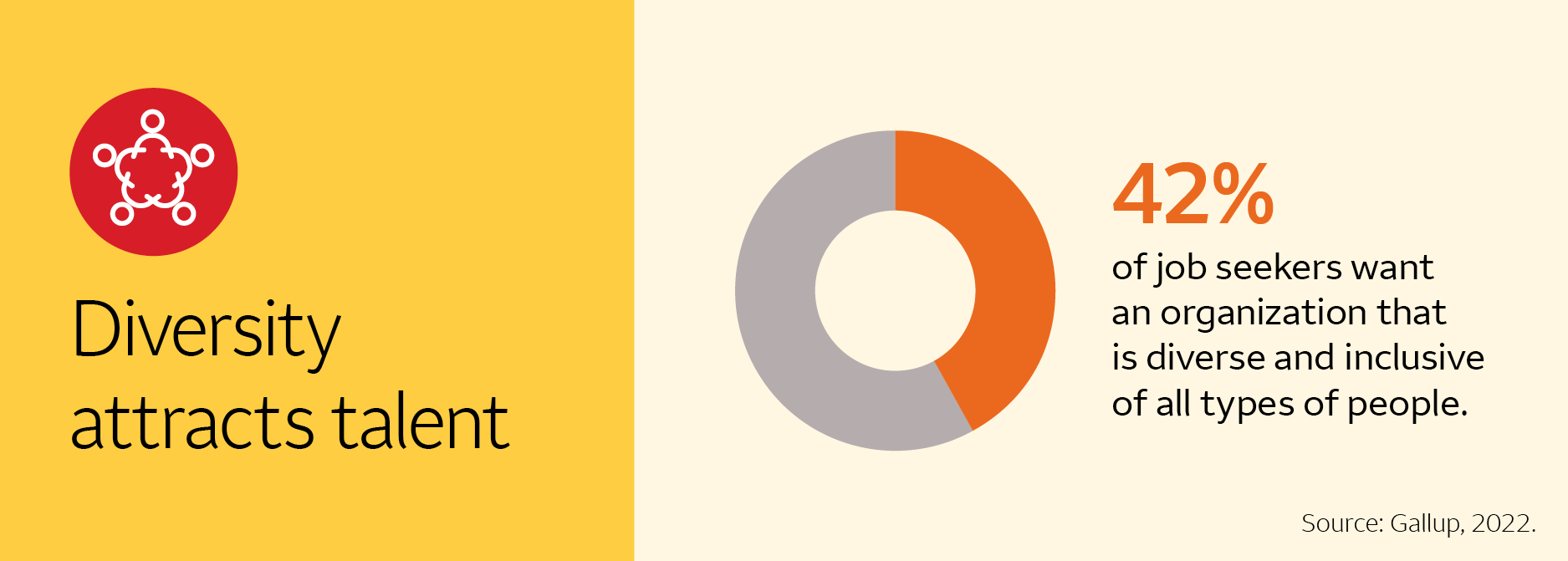Integrating diversity into your small business, from suppliers to employees, can help you grow.
Diversity in business can be a game-changer. While it’s often discussed in the context of Fortune 500 companies, small businesses can reap the many benefits as well. When you build relationships — internally, as well as with partners and vendors — that reflect a variety of backgrounds and perspectives, it can lead to innovation and growth, as well as a deeper connection with your customers.
What is diversity?
We traditionally think of diversity as a range of different social and ethnic backgrounds, including different genders, sexual orientations, races, religions, and more.
In business, diversity can also refer to diversity of thought or experience, like living abroad or having worked in a different field.
What are the benefits?
Working with a diverse group of people, from your suppliers to your staff, can provide inspiration. When you bring together unique and different perspectives, the conversations and ideas tend to be more nuanced, richer, and more representative. This may ultimately lead to a better business, from operations and products to the customers you attract.
At larger corporations, diversity is often linked directly to innovation and revenue driven by innovation. You can apply this same thinking to your business.
In fact, a diverse staff may be able to better connect with your current customers or help you win new customers. If someone on your team shares an ethnicity with a potential client, they’re more likely to understand that client and help you win that business.
How can I build a more diverse team?
If you have few (or no) employees, you can still reap the benefits of a diverse network. Apply the same thinking to your suppliers, partners, contractors, and so on.
To build a diverse team, first evaluate what voices and perspectives may be missing. For instance, if you notice a large number of your clients are Latino, and you don’t have any Latino employees or consultants, you could be missing an opportunity.
Next, reach outside your network when hiring or sourcing. We often hire from within our immediate circle or based on referrals from our close contacts, and this can narrow our reach. Instead, post jobs on message boards and websites aimed at broadening your pool.

![]()
Action tip: Try to incorporate diversity beyond your immediate team; actively seek out diverse suppliers and vendors.
In addition to diversity on your team (and with your partners), think about how you attract diverse customers. Do your marketing materials show people of all races and genders? Do you make sure all of your customers are treated respectfully, regardless of background, income level, or age?
These may seem like small or obvious steps, but they add up and make a big difference to how your company is perceived.
How can I foster innovation?
It’s not enough to hire people with diverse perspectives. In order to build a diverse workplace — and harness the innovation that it can create — you need to make sure your team and network feel supported.
To build a culture that fosters collaboration and creativity, consider who you consult on important decisions and how you react to ideas from team members. For instance, it’s normal to value the opinions of trusted advisors more highly. But what might this preference look like to another, newer team member? Might it appear that you’re discounting the opinions of others?
![]()
Action tip: Seek out ideas that might challenge your point of view as the business owner. It may mean asking suppliers, advisors, and even customers for feedback. Even if you don’t change your mind, your original idea may become stronger in the process.
Develop a system that allows people (employees, consultants, partners, or anyone else you work with) to share open and honest feedback. A more formal process can make it easier for team members to share concerns or suggestions than a face-to-face conversation. Making it a system means fostering diverse opinions that will become part of your workplace culture as you grow your business.
While prioritizing diversity, it’s also important to ensure that your workplace environment — physically and culturally — is welcoming to all. For example, if you are bringing on a new hire who uses a wheelchair, make sure the office is set up so that person has the same access as all other staff.
![]()
Action tip: Avoid putting people on the spot about their unique experience. Focus on making people comfortable enough to share, versus requiring they do so.
Building a diverse network and team can lead to direct business outcomes, but it’s about more than business. Fostering diversity should be done thoughtfully. Focus on creating an inclusive business that represents a variety of individuals and ideas. Empathy and innovation could very well go hand in hand.





